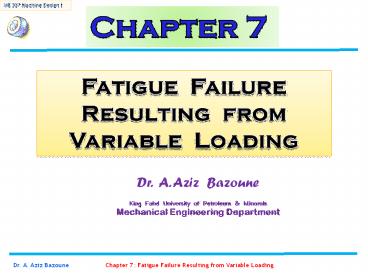Fatigue Failure Resulting from Variable Loading - PowerPoint PPT Presentation
1 / 18
Title:
Fatigue Failure Resulting from Variable Loading
Description:
Dr. A. Aziz Bazoune King Fahd University of Petroleum & Minerals Mechanical Engineering Department CH-07 LEC 25 Slide * CH-07 LEC 25 Slide * 7-11 ... – PowerPoint PPT presentation
Number of Views:506
Avg rating:3.0/5.0
Title: Fatigue Failure Resulting from Variable Loading
1
Chapter 7
Fatigue Failure Resulting from Variable
Loading
Dr. A. Aziz Bazoune King Fahd University of
Petroleum Minerals Mechanical Engineering
Department
2
LECTURE 25
3
7-11 Characterizing Fluctuating Stresses
- Fluctuating stresses in machinery often take the
form of sinusoidal pattern because of the nature
of the nature of some rotating machinery. - Other patterns some quite irregular do occur.
4
7-11 Characterizing Fluctuating Stresses
- In periodic patterns exhibiting a single maximum
and single minimum of force, the shape of the
wave is not important. - The peaks on both sides (maximum, minimum) are
important. - Fmax and Fmin in a cycle can be used to
characterize the force pattern. - A steady component and an alternating component
can be constructed as follows
5
(No Transcript)
6
(No Transcript)
7
Any varying stress with a nonzero mean is
considered a fluctuating stress.
8
(No Transcript)
9
- The steady, or static, stress is not the same as
the midrange stress. - The steady stress may have any value between smin
and smin . - The steady stress exists because of a fixed load
or preload applied to a part. - The steady load is independent of the varying
portion of the load.
10
- A helical compression spring is always loaded
into a space shorter than the free length of the
spring. - The stress created by this initial compression is
called the steady, or static, component of the
stress.
11
- Equations (7-39) use symbols sa and sm as the
stress components at the location of scrutiny. - In the absence of a notch, sa and sm are equal
to the nominal stresses sao and smo induced by
loads Fa and Fm , respectively. - With a notch they are sa Kf sao and sm Kf
smo , respectively.
12
- When the steady stress component is high enough
to induce localized notch yielding, the designer
has problem. - The first-cycle local yielding produces plastic
strain and strain-strengthening. - This is occurring at the location where fatigue
crack nucleation and growth are most likely.
13
Possible ways of quantifying the problem
- Residual Stress Method
- All stresses (both mean and alternating) are
multiplied by the fatigue stress concentration
factor Kf , and correction is made for yielding
and resultant residual stresses if the calculated
peak stress exceeds the material yield strength. - Nominal Mean Stress Method
- In this method, stress concentration factor is
applied only to alternating stress. - Reduction in mean stress from not multiplying it
by Kf , might be about the same as the reduction
in mean stress achieved with the residual stress
method by taking yielding and residual stress
into account.
14
7-12 Fatigue Failure Criteria for Fluctuating
Stress
- After having defined the various components of
stress associated with a part subjected to
fluctuating stresses, we want to vary both the
midrange stress and the stress amplitude or
alternating component, to learn about the FATIGUE
RESISTANCE of parts when subjected to such
situations. - Many machine elements involve fluctuating
stresses about a non-zero mean. - The influence of non-zero mean stress is
estimated by using one of several empirical
relationships that determine failure at a given
life when both alternating and mean stresses are
nonzero.
15
(No Transcript)
16
Modified Goodman Diagram
- It has midrange stress plotted along the abscissa
and all other components of stress plotted on
the ordinate, with tension in the positive
direction. - The endurance limit, fatigue strength, or
finite-life strength whichever applies, is
plotted on the ordinate above and below the
origin. - The midrange line is a 45o line from the origin
to the tensile strength of the part.
Figure 7-24 Modified Goodman diagram showing all
the strengths and the limiting values of all the
stress components for a particular midrange stress
17
Plot of Fatigue Failures for Midrange Stresses in
both Tensile and Compressive Regions.
Figure 7-25 Plot of fatigue failures for midrange
stresses in both tensile and compressive regions.
Normalizing the data by using the ratio of steady
strength components to tensile strength Sm/Sut,
steady strength component to compressive strength
Sm/Suc, and strength amplitude component to
endurance limit Sa/Se enables a plot of
experimental results for a variety of steels.
18
(No Transcript)































